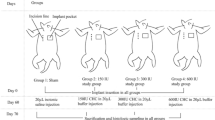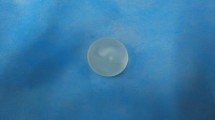Abstract
Background
Capsular contracture is the most common side effect of breast implant insertion and the problem that breast surgeons seek to avoid the most. Previous animal studies have proved that an antiadhesive barrier solution (AABS) prevents peri-implant capsule formation. In this study, the authors sought to explore the effect that Guardix-SG®, an AABS that can encapsulate implants in the form of a gel, can have on capsular contracture.
Method
This study used 12 female New Zealand white rabbits weighing 2.5–3 kg. Implants were inserted into the subpanniculus carnosus plane through an incision in the bilateral midback area. Once the implant was inserted, 3 g of Guardix-SG® and normal saline were instilled into the left and right sides, respectively. The rabbits were killed 6 months after the procedure. The intracapsular pressure was measured using tonometry with a 38.2-g circular glass piece, and capsular thickness was measured by dyeing the biopsy specimen with hematoxylin and eosin and Masson’s trichrome stain. The myofibroblasts were quantitatively analyzed through monoclonal anti-alpha smooth muscle actin antibody immunohistochemistry staining.
Results
The intracapsular pressure in the control group (4.51 ± 0.98 mmHg) was significantly higher (p = 0.002) than in the study group (3.51 ± 0.4 mmHg). The average capsular thickness was significantly greater in the control group (0.33 ± 0.15 mm; p = 0.015). In the analysis, the interrelation between capsular thickness and intracapsular pressure was insignificant in both groups, as was the number of myofibroblasts in both groups (p = 0.582).
Conclusion
Through this study, the authors were able to demonstrate that capsular contracture can be suppressed in the rabbit model by instilling Guardix-SG® after insertion of cohesive gel implants in the subpanniculus carnosus plane.
Level of Evidence IV
This journal requires that authors assign a level of evidence to each article. For a full description of these Evidence-Based Medicine ratings, please refer to the Table of Contents or the online Instructions to Authors www.springer.com/00266.




Similar content being viewed by others
References
Lew DH, Yoon JH, Hong JW, Tark KC (2010) Efficacy of antiadhesion barrier solution on peri-implant capsule formation in a white rat model. Ann Plast Surg 65:254–258
Moore JR (1979) Applanation tonometry of breasts. Plast Reconstr Surg 63:9–12
Hakelius L, Ohlsén L (1997) Tendency to capsular contracture around smooth and textured gel-filled silicone mammary implants: a five-year follow-up. Plast Reconstr Surg 100:1566–1569
Burkhardt BR, Eades E (1995) The effect of Biocell texturing and povidone-iodine irrigation on capsular contracture around saline-inflatable breast implants. Plast Reconstr Surg 96:1317–1325
Smahel J (1977) Histology of the capsules causing constrictive fibrosis around breast implants. Br J Plast Surg 30:324–329
Shah Z, Lehman JA Jr, Tan J (1981) Does infection play a role in breast capsular contracture? Plast Reconstr Surg 68:34–42
Virden CP, Dobke MK, Stein P, Parsons CL, Frank DH (1992) Subclinical infection of the silicone breast implant surface as a possible cause of capsular contracture. Aesthetic Plast Surg 16:173–179
Baker JL Jr, Chandler ML, LeVier RR (1981) Occurrence and activity of myofibroblasts in human capsular tissue surrounding mammary implants. Plast Reconstr Surg 68:905–912
Friedman H, Stonerock C, Lefaivre J, Yost M (2004) The effect of seprafilm and interceed on capsule formation around silicone discs in a rat model. J Invest Surg 17:271–281
Nagakura T, Hirata H, Tsujii M, Sugimoto T, Miyamoto K, Horiuchi T, Nagao M, Nakashima T, Uchida A (2005) Effect of viscous injectable pure alginate sol on cultured fibroblasts. Plast Reconstr Surg 116:831–838
Oh SH, Kim JK, Song KS, Noh SM, Ghil SH, Yuk SH, Lee JH (2005) Prevention of postsurgical tissue adhesion by antiinflammatory drug-loaded pluronic mixtures with sol–gel transition behavior. J Biomed Mater Res A 72:306–316
Reigel DH, Bazmi B, Shih SR, Marquardt MD (1993) A pilot investigation of poloxamer 407 for the prevention of leptomeningeal adhesions in the rabbit. Pediatr Neurosurg 19:250–255
Zimman OA (2007) A rabbit model for capsular contracture: development and clinical implications. Plast Reconstr Surg 119:1955–1956
Bucky LP, Ehrlich HP, Sohoni S, May JW Jr. (1994) The capsule quality of saline-filled smooth silicone, textured silicone, and polyurethane implants in rabbits: a long-term study. Plast Reconstr Surg 93:1123–1131; (discussion 1132–1133)
Ajmal N, Riordan CL, Cardwell N, Nanney LB, Shack RB (2003) The effectiveness of sodium 2-mercaptoethane sulfonate (mesna) in reducing capsular formation around implants in a rabbit model. Plast Reconstr Surg 112:1455–1461; (discussion 1462–1463)
Uzunismail A, Perk C, Findik H, Beyhan G, Dincler M (2008) Effect of a fascial tissue interface on silicone implant capsule formation: a preliminary experimental study. J Plast Reconstr Aesthet Surg 61:1199–1204
Moufarrege R, Beauregard G, Bosse JP, Papillon J, Perras C (1987) Outcome of mammary capsulotomies. Ann Plast Surg 19:62–64
Ersek RA (1991) Rate and incidence of capsular contracture: a comparison of smooth and textured silicone double-lumen breast prostheses. Plast Reconstr Surg 87:879–884
Collis N, Coleman D, Foo IT, Sharpe DT (2000) Ten-year review of a prospective randomized controlled trial of textured versus smooth subglandular silicone gel breast implants. Plast Reconstr Surg 106:786–791
Hwang K, Sim HB, Huan F, Kim DJ (2010) Myofibroblasts and capsular tissue tension in breast capsular contracture. Aesthetic Plast Surg 34:716–721
Acknowledgments
This study was supported by Genewel, a Dongsung Company, Seongnam City, Korea.
Conflict of interest
None.
Author information
Authors and Affiliations
Corresponding author
Rights and permissions
About this article
Cite this article
Park, S.O., Han, J., Minn, K.W. et al. Prevention of Capsular Contracture with Guardix-SG® After Silicone Implant Insertion. Aesth Plast Surg 37, 543–548 (2013). https://doi.org/10.1007/s00266-013-0087-3
Received:
Accepted:
Published:
Issue Date:
DOI: https://doi.org/10.1007/s00266-013-0087-3




